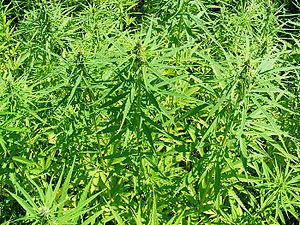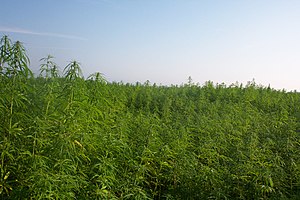 |
| Image via Wikipedia |
 |
| Image via Wikipedia |
 |
| Image via Wikipedia |
| Here is an interesting and enlightening assortment of hemp facts: 1) Hemp is among the oldest industries on the planet, going back more than 10,000 years to the beginnings of pottery. The Columbia History of the World states that the oldest relic of human industry is a bit of hemp fabric dating back to approximately 8,000 BC. 2) Presidents Washington and Jefferson both grew hemp. Americans were legally bound to grow hemp during the Colonial Era and Early Republic. The federal government subsidized hemp during the Second World War and U.S. farmers grew about a million acres of hemp as part of that program. 3) Hemp seed is nutritious and contains more essential fatty acids than any other source, is second only to soybeans in complete protein (but is more digestible by humans), is high in B-vitamins, and is a good source of dietary fiber. Hemp seed is not psychoactive and cannot be used as a drug (learn more at TestPledge.com). 4) The bark of the hemp stalk contains bast fibers, which are among the Earth's longest natural soft fibers and are also rich in cellulose. The cellulose and hemi-cellulose in its inner woody core are called hurds. Hemp stalk is not psychoactive. Hemp fiber is longer, stronger, more absorbent and more insulative than cotton fiber. 5) According to the Department of Energy, hemp as a biomass fuel producer requires the least specialized growing and processing procedures of all hemp products. The hydrocarbons in hemp can be processed into a wide range of biomass energy sources, from fuel pellets to liquid fuels and gas. Development of bio-fuels could significantly reduce our consumption of fossil fuels and nuclear power. 6) Hemp can be grown organically. Only eight, out of about one hundred known pests, cause problems, and hemp is most often grown without herbicides, fungicides or pesticides. Hemp is also a natural weed suppressor due to fast growth of the canopy. 7) Hemp produces more pulp per acre than timber on a sustainable basis, and can be used for every quality of paper. Hemp paper manufacturing can reduce wastewater contamination. Hemp's low lignin content reduces the need for acids used in pulping, and its creamy color lends itself to environmentally-friendly bleaching instead of harsh chlorine compounds. Less bleaching results in less dioxin and fewer chemical by-products. 8) Hemp fiber paper resists decomposition, and does not yellow with age when an acid-free process is used. Hemp paper more than 1,500 years old has been found. Hemp paper can also be recycled more times than wood-based paper. 9) Hemp fiberboard produced by Washington State University was found to be twice as strong as wood-based fiberboard. No additional resins are required due to naturally-occurring lignins. 10) Eco-friendly hemp can replace most toxic petrochemical products. Research is being done to use hemp in manufacturing biodegradable plastic products: plant-based cellophane, recycled plastic mixed with hemp for injection-molded products, and resins made from the oil, to name a very few examples. Over two million cars on the road today have hemp composite parts for door panels, dashboards, luggage racks, etc. |
| Countries Growing Industrial Hemp Today |
| The U.S. is the only industrialized nation in the world that does not recognize the value of industrial hemp and permit its production. Below is a list of other countries that are more rational when it comes to hemp policy. |
| AUSTRALIA began research trials in Tasmania in 1995. Victoria commercial production since1998. New South Wales has research. In 2002, Queensland began production. Western Australia licensed crops in 2004. AUSTRIA has a hemp industry including production of hemp seed oil, medicinals and Hanf magazine. CANADA started to license research crops in 1994. In addition to crops for fiber, one seed crop was licensed in 1995. Many acres were planted in 1997. Licenses for commercial agriculture saw thousands of acres planted in 1998. 30,000 acres were planted in 1999. In 2000, due to speculative investing, 12,250 acres were sown. In 2001, 92 farmers grew 3,250 acres. A number of Canadian farmers are now growing organically-certified hemp crops (6,000 acres in 2003 and 8,500 acres in 2004, yielding almost four million pounds of seed). CHILE has grown hemp in the recent past for seed oil production. CHINA is the largest exporter of hemp textiles. The fabrics are of excellent quality. Medium density fiber board is also now available. The Chinese word for hemp is "ma." DENMARK planted its first modern hemp trial crops in 1997. The country is committed to utilizing organic methods. FINLAND had a resurgence of hemp in 1995 with several small test plots. A seed variety for northern climates was developed called Finola, previously know by the breeder code "FIN-314." In 2003, Finola was accepted to the EU list of subsidized hemp cultivars. Hemp has never been prohibited in Finland. The Finnish word for hemp is "hamppu." FRANCE has never prohibited hemp and harvested 10,000 tons of fiber in 1994. France is a source of low-THC-producing hemp seed for other countries. France exports high quality hemp oil to the U.S. The French word for hemp is "chanvre." GERMANY banned hemp in 1982, but research began again in 1992, and many technologies and products are now being developed, as the ban was lifted on growing hemp in November, 1995. Food, clothes and paper are also being made from imported raw materials. Mercedes and BMW use hemp fiber for composites in door panels, dashboards, etc. The German word for hemp is "hanf." GREAT BRITAIN lifted hemp prohibition in 1993. Animal bedding, paper and textiles markets have been developed. A government grant was given to develop new markets for natural fibers. 4,000 acres were grown in 1994. Subsidies of 230 British pounds per acre are given by the government to farmers for growing hemp. HUNGARY is rebuilding their hemp industry, and is one of the biggest exporters of hemp cordage, rugs and fabric to the U.S. They also export hemp seed, paper and fiberboard. The Hungarian word for hemp is "kender." INDIA has stands of naturalized Cannabis and uses it for cordage, textiles and seed. ITALY has invested in the resurgence of hemp, especially for textile production. 1,000 acres were planted for fiber in 2002. Giorgio Armani grows its own hemp for specialized textiles. JAPAN has a rich religious tradition involving hemp, and custom requires that the Emperor and Shinto priests wear hemp garments in certain ceremonies, so there are small plots maintained for these purposes. Traditional spice mixes also include hemp seed. Japan supports a thriving retail market for a variety of hemp products. The Japanese word for hemp is "asa." NETHERLANDS is conducting a four-year study to evaluate and test hemp for paper, and is developing specialized processing equipment. Seed breeders are developing new strains of low-THC varieties. The Dutch word for hemp is "hennep." NEW ZEALAND started hemp trials in 2001. Various cultivars are being planted in the north and south islands. POLAND currently grows hemp for fabric and cordage and manufactures hemp particle board. They have demonstrated the benefits of using hemp to cleanse soils contaminated by heavy metals. The Polish word for hemp is "konopij." ROMANIA is the largest commercial producer of hemp in Europe. 1993 acreage was 40,000 acres. Some of it is exported to Hungary for processing. They also export hemp to Western Europe and the U.S. The Romanian word for hemp is "cinepa." RUSSIA maintains the largest hemp germplasm collection in the world at the N.I. Vavilov Scientific Research Institute of Plant Industry (VIR) in St. Petersburg. They are in need of funding to maintain and support the collection. The Russian word for hemp is "konoplya." SLOVENIA grows hemp and manufactures currency paper. SPAIN has never prohibited hemp, produces rope and textiles, and exports hemp pulp for paper. The Spanish word for hemp is "cañamo." SWITZERLAND is a producer of hemp and hosts one of the largest hemp trade events, Cannatrade. TURKEY has grown hemp for 2,800 years for rope, caulking, birdseed, paper and fuel. The Turkish word for hemp is "kendir." UKRAINE, EGYPT, KOREA, PORTUGAL and THAILAND also produce hemp. UNITED STATES granted the first hemp permit in over 40 years to Hawaii for an experimental quarter-acre plot in 1999. The license was renewed, but the project has since been closed due to DEA stalling tactics and related funding problems. Importers and manufacturers have thrived using imported raw materials. 22 states have introduced legislation, including VT, HI, ND, MT, MN, IL, VA, NM, CA, AR, KY, MD, WV and ME, addressing support, research or cultivation with bills or resolutions. The National Conference of State Legislators (NCSL) has endorsed industrial hemp for years. |
| Bibliography |
| Chris Conrad, "Hemp: Lifeline to the Future" Jack Frazier, "The Great American Hemp Industry" Hemptech, "Industrial Hemp" and "Hemp Horizons" Acknowledgements: Hemp Industries Association |

3 comments:
iphone 6s cases, chi flat iron, ipad cases, north face outlet, hollister, ralph lauren, wedding dresses, nike air max, north face outlet, louboutin, baseball bats, insanity workout, iphone 6 plus cases, soccer jerseys, celine handbags, asics running shoes, ferragamo shoes, mcm handbags, valentino shoes, p90x workout, nike roshe run, babyliss, timberland boots, nfl jerseys, iphone cases, lululemon, iphone 5s cases, ghd hair, iphone 6 cases, mont blanc pens, longchamp uk, hollister clothing, beats by dre, reebok outlet, instyler, s6 case, oakley, bottega veneta, hermes belt, soccer shoes, herve leger, jimmy choo outlet, mac cosmetics, abercrombie and fitch, new balance shoes, nike trainers uk, iphone 6s plus cases, nike huaraches
golden goose sneakers
goyard
yeezy
yeezy supply
balenciaga
yeezy
yeezy
air jordan
yeezy
yeezy shoes
useful site replica bags buy online look at this website Ysl replica bags click to find out more aaa replica bags
Post a Comment